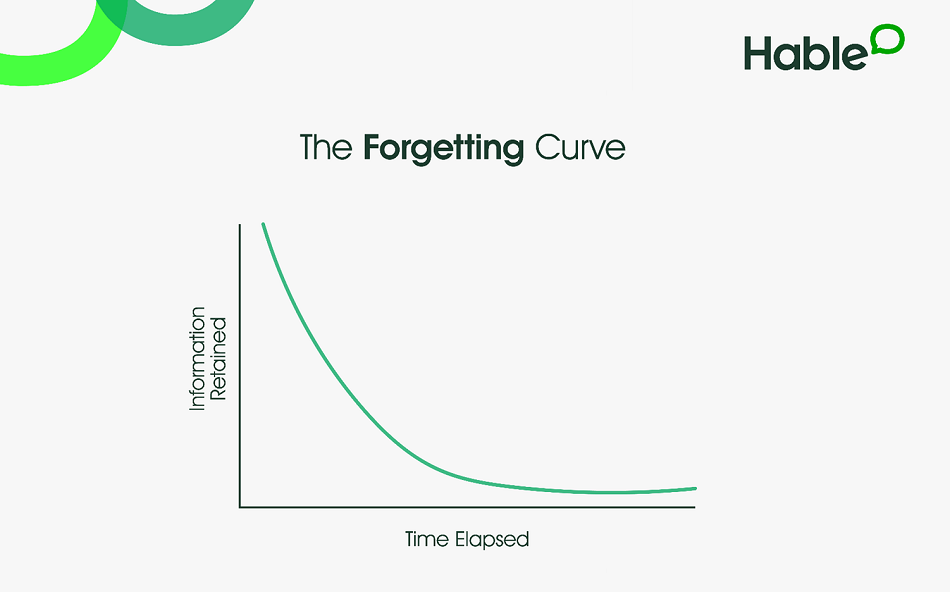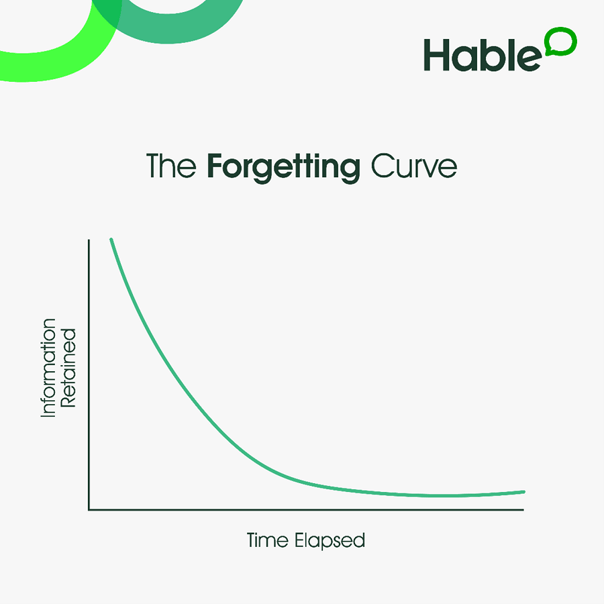
When improving widespread adoption of technology, providing effective learning experiences is key. If people aren’t confident in how to use technology, they simply won’t use it.
But knowledge learnt fades over time, and information is lost when you don’t make an effort to actively retain it. That’s the ‘forgetting curve’ theory.
What is the Ebbinghaus Forgetting Curve?
Hermann Ebbinghaus was a pioneering German psychologist, who dedicated much of his professional career to researching memory. In one particular experiment, he wanted to test his own memory over a period of time.
He gathered data around how well he was recalling information he had learnt, plotted it on a graph, and was presented with something that looked like this:

To him this showed the natural loss of memories and ability to remember information over time.
Apply this to the adoption of new technology, and we can take away some useful learnings: people need to keep learning something to understand it. You can’t just give people one training session on SharePoint and expect them to get on with it.
Rather, the learning needs to be consistently repeated over a period of time.
How can we combat the forgetting curve?
The forgetting curve is a natural loss of memory over time. But there are ways that you can ensure the retention of useful information, something that is crucial to the widespread adoption of technology. Here's how:
1. Use spaced repetition
During his experiment, Ebbinghaus also noticed that the speed of forgetting slowed significantly when exposed to information again and again.
With this in mind, he determined that the best way to combat the forgetting curve was through spaced intervals of learning - or “spaced repetition.”
We can apply these findings in the adoption of new technology, too. Ensuring people are exposed to frequent learning as part of a wider programme, to help really embed and solidify knowledge. This has far greater impact than a one off training session.
2. Keep it relevant
Off-the-shelf learning has its benefits. It's cost effective for organisations and is easy to access. However, in the long-term it won’t have the same impact as a something that is created bespoke for your organisation, and made relevant to your audience with scenarios. Learners need to connect to the content that they’re being taught. The more relevant it is to them and their roles, the more likely they are to retain information.
3. Make it interactive
Interaction is key for learners. The more interactive a session is, the better people learn. A study from Carnegie Mellon University actually found that that interactive activities are 6x more likely to help students learn than non-interactive activities.
It's important to ensure you’re giving learners the opportunity to get actively involved in learning programmes, rather than talking at them.
4. Continue the support
Similar to the idea of spaced repetition, it’s crucial that support is ongoing too. You can run a workshop on OneDrive, for example, but without continued support, what are learners likely to do?
They might search online for their answer, ask a colleague. And if they can’t find it? They’re likely to use a different tool or not bother at all.
This is why ongoing support is an important part of combatting the forgetting curve, and subsequently to the adoption of new technologies.
Whether that support comes from coaches, an online forum, or materials that can be accessed to support self-learning.
The Forgetting Curve - Download as a PDF Guide
You can download this introduction to the Forgetting Curve and how to combat it as a PDF guide to refer back to when you need, or to share around with your team.
We know how people learn. And how people forget.
Hable have been delivering outstanding learning programmes for almost a decade. In that time, we have trained thousands of people at some of the biggest organisations and most prestigious institutions. Inspiring them to learn new skills, embrace change and unlock the potential of technology.
If you want to provide your people with a learning experience that sticks - get in touch!
Learning with long-lasting impact
We don't just provide training, we provide learning experiences. Designed to improve confidence, skills, and adoption of new technology. Helping you achieve return on your investment into technology.


